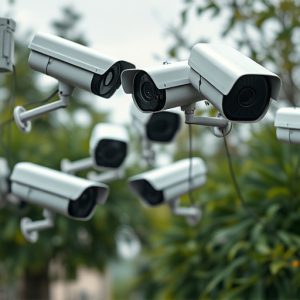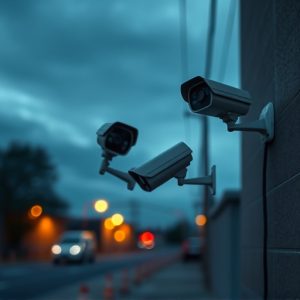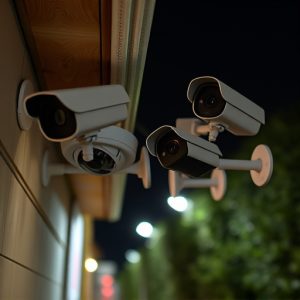Maximizing Home Security with Faux Cameras: A Guide to Effective Deterrence
Fake security cameras can be an effective component of a home defense strategy when used intelligen…….
Fake security cameras can be an effective component of a home defense strategy when used intelligently as part of a broader security plan. These devices, which convincingly mimic real cameras with features like flashing red lights and weatherproof housing, act primarily as psychological deterrents by giving the appearance of continuous surveillance. While they do not record footage, their strategic placement in high-traffic areas and visibility can complement actual surveillance systems, motion-sensor lights, and other security measures to significantly reduce the risk of theft or burglary. When integrated with real cameras and companion apps for remote monitoring, dummy units enhance a home's security posture without requiring an expensive, comprehensive surveillance setup. Addressing the question "Do fake security cameras work?" their utility is undeniable when they are of high quality, well-placed, and part of a thoughtfully designed security system.
When securing your home, the visual deterrence of surveillance is a key factor. In recent years, the debate has swelled around the efficacy of fake security cameras as a protective measure. This article demystifies their role in home defense, detailing how well they work to safeguard your property. We explore the intricacies of high-quality dummy cameras, their strategic placement for optimal deterrence, and weigh the real versus the replicated in the context of home security. Whether considering a supplementary layer of protection or solely relying on this visual strategy, understanding fake security cameras is essential for informed decision-making. Join us as we dissect the practicality and impact of these decoys in your home defense system.
Understanding Fake Security Cameras: A Comprehensive Guide
While the concept of fake security cameras may seem counterintuitive, they play a strategic role in enhancing home security. Unlike their real counterparts, these dummy cameras are designed to deceive potential intruders. They often feature authentic-looking lenses and sometimes even blinking red lights to mimic the operational appearance of surveillance equipment. The effectiveness of fake cameras hinges on their placement and design; they should be conspicuous enough to deter thieves but not so sophisticated that one cannot tell they are not functional. It’s crucial to understand that while these cameras may deter some criminals, they are not a substitute for real security systems. They can serve as a first line of defense in areas where installing actual surveillance cameras is impractical due to budget constraints or other considerations. When considering fake security cameras, it’s important to evaluate the quality and design to ensure they convincingly resemble real cameras, thereby maximizing their deterrent effect. Additionally, integrating them with a comprehensive security plan that includes visible alarm signs, motion-activated lights, and actual surveillance in critical areas can provide a robust home defense strategy. Understanding their limitations and strategic placement can make fake security cameras a valuable component of your overall home security system.
The Design and Features of Effective Dummy Cameras
When considering the enhancement of home security measures, dummy cameras serve as a cost-effective and visually convincing deterrent against potential intruders. These effective fake security cameras are meticulously designed to mimic the appearance of their operational counterparts, often incorporating flashing red lights or blinking LEDs to convince onlookers, including would-be thieves, that they are actively recording. The exterior shell of a high-quality dummy camera is typically crafted with attention to detail, ensuring it resembles real security cameras in size, shape, and color. This attention to appearance is crucial because it’s often the visual presence that acts as a deterrent rather than actual surveillance.
Furthermore, while some may question the efficacy of such devices, asking “do fake security cameras work?” their utility extends beyond mere appearance. Many models come with additional features that enhance their realism. These can include weatherproof housing to withstand outdoor elements, adjustable mounting options for versatile placement, and even motion sensors that trigger the aforementioned LED lights or emit a loud alarm sound when disturbed. Some high-end dummy cameras also offer remote monitoring capabilities through a companion app, allowing users to view live footage from real security cameras connected to the system, thus blending practicality with the deception of dummy units for a comprehensive home security strategy.
Strategic Placement for Maximum Deterrence
When considering the deployment of fake security cameras for home defense, strategic placement is paramount for maximizing deterrence. Unlike their real counterparts, the effectiveness of dummy cameras hinges on their visibility and positioning. Positioning these decoys in highly conspicuous areas can create a strong psychological impact on potential intruders. Commonly targeted locations include entry points such as front and back doors, as well as corners of windows where an actual camera might be less noticeable. The idea is to give the impression that the home is thoroughly monitored, which can discourage would-be thieves from attempting a break-in. Furthermore, placing dummy cameras at heights or angles that real surveillance equipment often covers can enhance the illusion of a comprehensive security system. It’s a cost-effective measure that, when combined with other security practices, can significantly contribute to the protection of one’s home. To maximize their effectiveness, it’s advisable to pair fake cameras with motion-sensor lights or real security cameras at less obvious locations, thus creating a layered defense that is harder for intruders to assess at a glance. This approach, when executed thoughtfully, can effectively support your home’s security strategy without the need for complex surveillance installations.
Real vs. Fake: Assessing the Efficacy of Fake Security Cameras in Home Defense
When considering home defense, the presence of security cameras can be a significant deterrent to potential intruders. The efficacy of these surveillance systems hinges on their perceived functionality rather than their actual operational status. Real versus fake security cameras present two distinct approaches to safeguarding one’s property. While authentic surveillance systems record and transmit footage, fake cameras serve as a visual cue that deters theft.
The debate over whether fake security cameras work centers on their ability to dissuade criminal activity. It’s a common misconception that ineffective cameras are easily spotted and thus ineffective. However, the principal advantage of dome or bullet-shaped fake cameras lies in their visibility, which signals to potential intruders that they may be under surveillance. These decoys can be highly effective when strategically placed to cover blind spots where real cameras might not be feasible. Their role is not to capture footage but to create the perception of a comprehensive monitoring system, thereby deterring criminal activity before it begins. This psychological deterrent is a critical component of home defense strategies, complementing the physical security measures in place.


